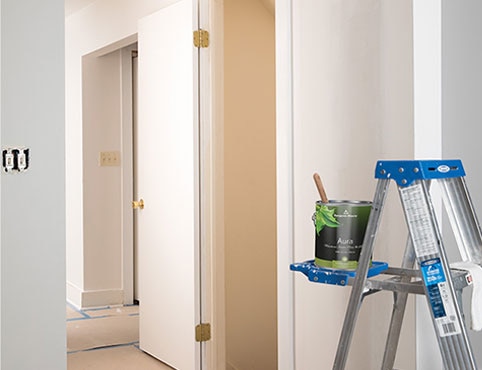6 Tips For Storing Leftover Paint & Shelf Life
With your painting project finished and your clean-up nearly completed, a common question may come to mind: How do I store leftover paint?

6 Things to Know about Storing Leftover Paint and Shelf Life
1. Where to Store Leftover Paint
Store leftover paint in a dry place that is out of direct sunlight. Paint should be stored out of the reach of children and away from food and drink. Most types of leftover latex paint, including AURA®, REGAL® and ben®, should be stored either in a lined metal can to prevent rust, or in a glass or plastic container.
- Helpful Tip: If you’re not using the original paint can, your storage container should not be much bigger than the amount of paint that is left to limit air exposure.
2. At What Temperature Should You Store Paint?
The temperature for storing paint should be between 60 and 80 degrees Fahrenheit (15-27 Celsius).
- Helpful Tip: Consider the climate you live in when storing paint in the garage—make sure it doesn’t freeze.
3. How to Properly Reseal a Paint Can Lid
The number one rule in resealing a paint can is that the lid should always be put back on immediately. Be sure to clean the edge or rim of both the can and the lid to get the best seal possible. To achieve an air-tight seal, place a piece of plastic wrap between the lid and the opening of the paint can. For best results, close the can by using a rubber mallet to tap around the edges of the lid until it is firmly closed.
4. How Long Does Opened Paint Last?
Once opened, most paint products, including Benjamin Moore®, have a shelf life of two years. Considerations include environment, temperature fluctuations and other variables. When using Benjamin Moore® products, check the product’s Technical Data Sheet for specific details on storage temperatures.
5. How to Store Paint During a Project
If you’re in the middle of a project and need to take a break for a while, you can easily store paint for the short term (i.e., a few days or a week). Just be sure to reseal the can immediately and keep the paint in a temperate environment and not exposed to direct sunlight.
6. How to Determine If Paint Can No Longer Be Used
The main indicators that paint can no longer be used are smell and consistency.
- Smell: Paint that is beyond its shelf life can smell sour and strong.
- Consistency: After stirring, there should not be any chunks in or jelly-like texture to the paint—it should be smooth.
Using paint that has exceeded its shelf life may cause a lingering sour smell and inconsistent texture. If you suspect paint is past its prime, make sure you dispose of paint safely.
- Helpful Tip: If the paint has not yet hit the two-year mark (or slightly longer with proper storage techniques), has no strong odour (no rotting egg smell), and has a smooth consistency, then it should still be good to use!
Reusing your paint and painting tools? Make sure you properly clean and store paint brushes and rollers to make them last from project to project. Visit your local Benjamin Moore® retailer for help with all your painting needs, and find more tips in our How-To section.
Helpful Tip
To make touch-ups much easier and more accurate, label the can and/or the back of a light switch in a room you’ve painted with:• Brand of Paint
• Color
• Type or Product Name
• Sheen/Finish
• Where/What You’ve Painted (room, wall, piece of furniture, etc.)




